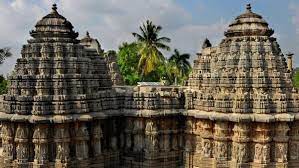Sacred Ensembles Of The Hoysalas : UNESCO’s World Heritage List

The Sacred Ensembles of the Hoysalas, which include three temples in Karnataka, have been inscribed on UNESCO’s World Heritage List.
- The Sacred Ensembles of the Hoysalas consist of a collection of Hoysala temples.
- These were built in the 12th-13th centuries and are represented here by the three components of Belur, Halebid, and Somnathapura.
- The three temples include;
- The Chennakeshava temple: It is the main temple in the complex at Belur (Hassan district), located at the centre of the traditional settlement, which is surrounded by the remnants of a mud fort and a moat.
- The Hoysaleswara Temple: It is on the banks of the Dwarasamudra tank in Halebidu (Hassan district), a town which has many protected and unprotected temples, archaeological ruins, and mounds.
- The Keshava Temple: It is at the centre of Somanathapura village (Mysore district).
These are primarily dedicated to Hindu deities like Shiva and Vishnu, with some also devoted to the Jain faith.
- The Hoysala temples have a basic Dravidian morphology but show strong influences of the Bhumija mode widely used in Central India, the Nagara traditions of northern and western India, and the Karntata-Dravida modes favoured by the Kalyani Chalukyas.




